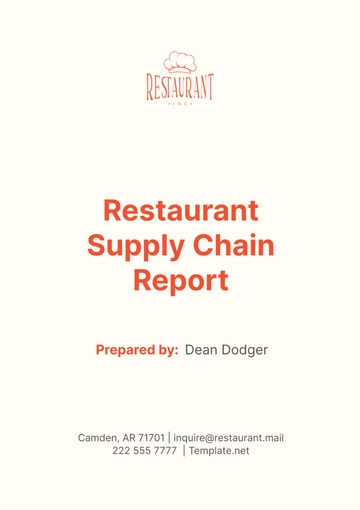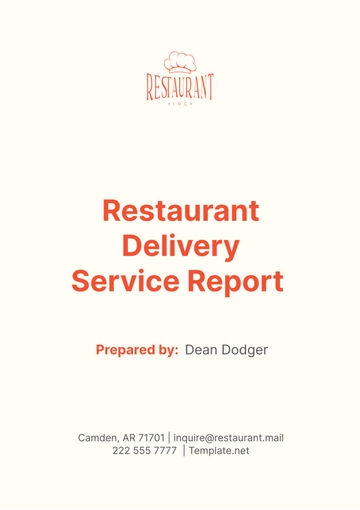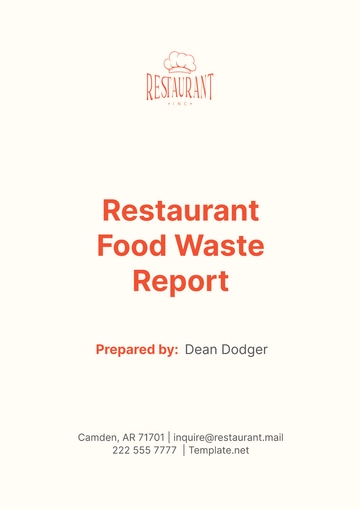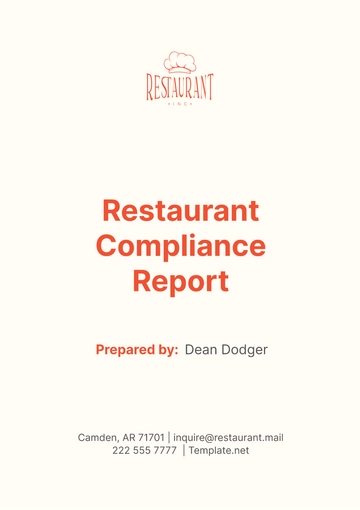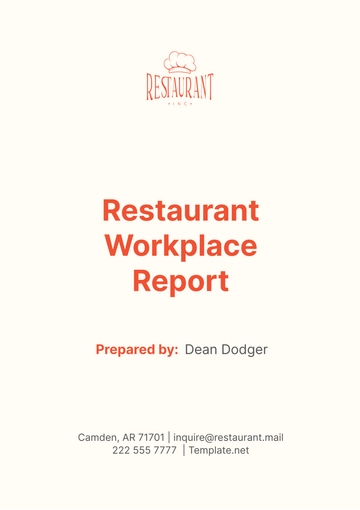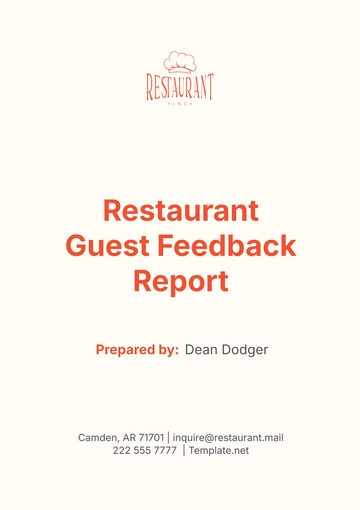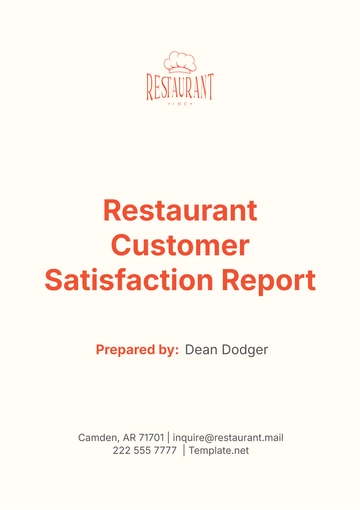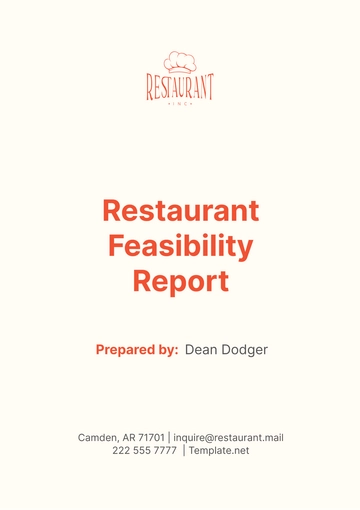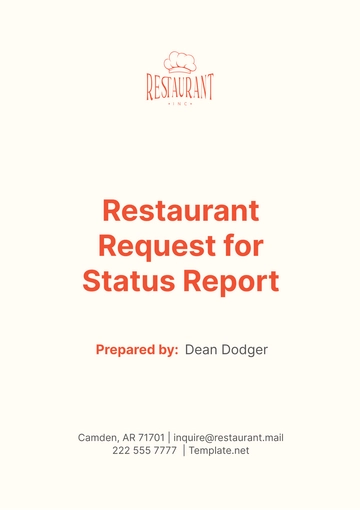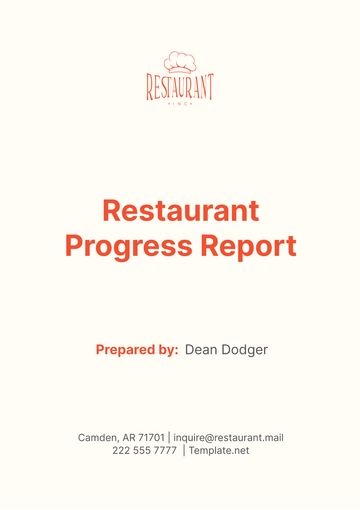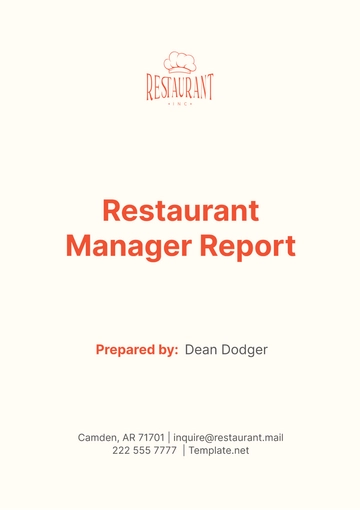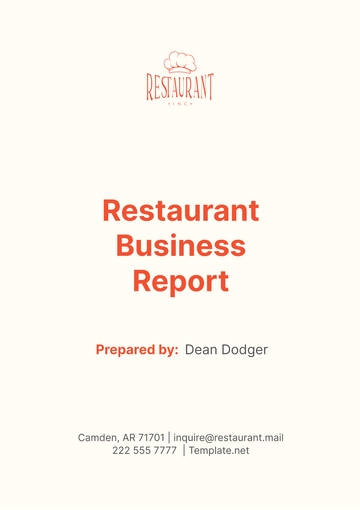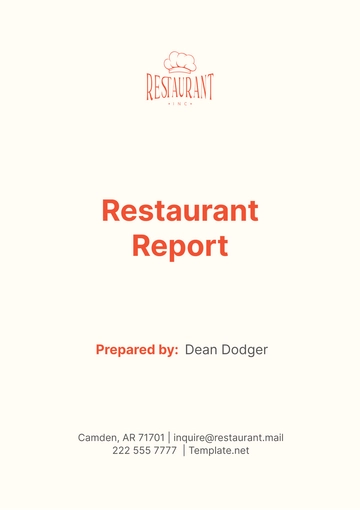Free Restaurant Manager Report
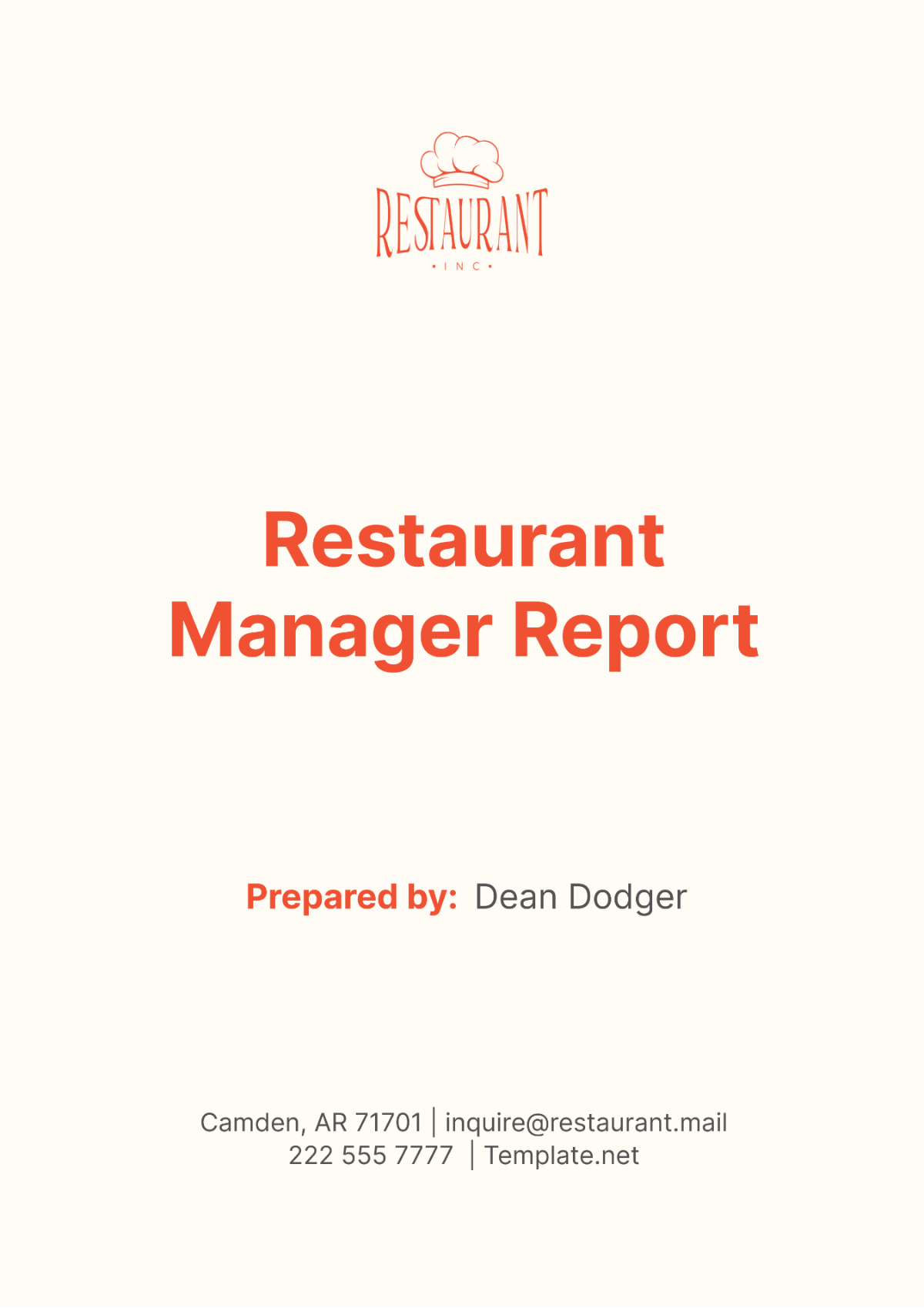
I. Executive Summary
This report for [Your Company Name] serves as a comprehensive document that encapsulates the key operational outcomes, financial performance, and customer service metrics during the specified reporting period. This report is meticulously designed to provide a detailed overview of our restaurant’s performance, thereby offering valuable insights that can guide strategic decision-making and future planning.
The primary objective of this report is to ensure a clear understanding of our restaurant’s current operational status, financial health, and customer satisfaction levels. It serves as a tool for gauging our performance against set benchmarks and industry standards. The data and analysis presented in this report are aimed at fostering a culture of continuous improvement and operational excellence within our restaurant.
In essence, this report provides a snapshot of our restaurant’s performance in key areas such as revenue generation, cost management, service efficiency, and customer satisfaction. It highlights areas where we excel and identifies opportunities for improvement. By leveraging the insights from this report, we aim to enhance our operational efficiency, improve our financial performance, and deliver an exceptional dining experience to our customers. This commitment to continuous improvement and excellence is what sets [Your Company Name] apart and drives our success in the competitive restaurant industry.
II. Financial Overview
The financial overview is a critical component of the report for [Your Company Name]. It provides a comprehensive breakdown of our restaurant’s financial health, focusing on revenue streams, expenditure, and profit margins. The following table provides a summarized view of the fiscal data collected for the past reporting period:
Category | Amount | Change |
|---|---|---|
Total Revenue | $120,000 | +5% |
Cost of Goods Sold (COGS) | $35,000 | -2% |
Gross Profit | $85,000 | +7% |
Operating Expenses | $40,000 | 0% |
Net Profit | $45,000 | +10% |
A. Total Revenue
The total revenue of $120,000, marking a 5% increase, indicates a positive trend in our sales. This could be attributed to various factors such as effective marketing strategies, introduction of new menu items, or an increase in customer footfall. The growth in revenue is a positive sign and suggests that our restaurant is attracting customers and generating sales effectively.
B. Cost of Goods Sold (COGS)
The Cost of Goods Sold (COGS) stands at $35,000, showing a decrease of 2%. This reduction could be due to efficient inventory management, successful negotiation with suppliers for better prices, or reduction in food waste. Lower COGS is beneficial as it indicates improved cost efficiency in our restaurant operations.
C. Gross Profit
The gross profit, calculated as total revenue minus COGS, is $85,000, marking a 7% increase. This increase in gross profit indicates that our restaurant has been successful in generating revenue that significantly exceeds the direct costs associated with producing the goods sold (COGS). This is a positive indicator of our restaurant’s financial health and operational efficiency.
D. Operating Expenses
The operating expenses have remained constant at $40,000. These expenses include costs associated with the day-to-day operations of the restaurant, such as salaries, utilities, and rent. Maintaining steady operating expenses while increasing revenue and gross profit is a positive sign, indicating effective cost management.
E. Net Profit
The net profit, which is the gross profit minus operating expenses, stands at $45,000, marking a significant increase of 10%. This increase in net profit indicates that our restaurant is not only generating sufficient revenue to cover the costs but is also retaining a substantial portion of the revenue as profit. This is a strong indicator of our restaurant’s profitability and financial success.
The financial overview plays a pivotal role in the management and strategic planning of [Your Company Name]. It provides a clear picture of our financial performance and helps us make informed decisions about future investments, cost management strategies, and pricing policies. A thorough understanding of our financial health allows us to identify trends, anticipate challenges, and seize opportunities for growth. It helps us ensure the financial sustainability of our restaurant, which is crucial for long-term success.
Moreover, regular financial reporting promotes transparency and accountability. It allows us to track our progress towards our financial goals and measure the effectiveness of our strategies. By closely monitoring our financial performance, we can make timely adjustments to our strategies and ensure that [Your Company Name] continues to thrive in a competitive market.
III. Operational Analysis
Operational analysis is a crucial part of the report for [Your Company Name]. It provides insights into the efficiency and effectiveness of our restaurant operations, including staffing, inventory management, and customer service. The following table provides an overview of key performance indicators (KPIs) that reflect the operational performance of our restaurant:
KPI | Value |
|---|---|
Customer Wait Time (minutes) | 5 |
Employee Turnover Rate (%) | 10 |
Inventory Turnover Ratio | 12 |
Customer Satisfaction Score | 8.5/10 |
A. Customer Wait Time
The average customer wait time is 5 minutes. This is a critical metric as it directly impacts customer satisfaction. A low wait time suggests that our restaurant is efficiently managing its operations to promptly serve customers. However, there is always room for improvement. We could further reduce this wait time by optimizing our kitchen operations, improving staff training, or implementing a more efficient order management system.
B. Employee Turnover Rate
The employee turnover rate stands at 10%. While this is within the acceptable range for the restaurant industry, reducing this rate could lead to more stable operations and improved customer service. High turnover can disrupt operations and lead to inconsistent service. Strategies to reduce turnover might include improving working conditions, offering competitive compensation, or providing opportunities for career advancement.
C. Inventory Turnover Ratio
The inventory turnover ratio is 12. This indicates that our restaurant is effectively managing its inventory. A high turnover ratio suggests that we are selling our inventory quickly, which is beneficial for cash flow and reduces the risk of waste. However, it’s important to balance this with the risk of running out of key items. Regular inventory checks and a reliable supply chain can help maintain an optimal inventory level.
D. Customer Satisfaction Score
The customer satisfaction score is 8.5 out of 10. This high score reflects positively on our restaurant’s service quality, food quality, and overall dining experience. However, there’s always room to strive for a perfect score. We could aim to improve this score by seeking regular customer feedback, addressing any issues promptly, and continually improving our food and service.
Operational analysis is a powerful tool for improving restaurant performance. By tracking key performance indicators, we can gain valuable insights into our operations and make informed decisions. These metrics not only help us identify areas for improvement but also highlight our strengths. By focusing on these areas, we can enhance our operational efficiency, improve customer satisfaction, and drive business growth.
Moreover, regular operational analysis allows us to monitor trends over time, anticipate potential issues, and respond proactively. This proactive approach can lead to more efficient operations, better customer service, and improved profitability. At [Your Company Name], we are committed to continuous improvement and operational excellence. We believe that our focus on operational analysis plays a key role in achieving these goals.
IV. Customer Feedback and Satisfaction
Understanding and integrating customer feedback is pivotal for the sustained growth and improvement of [Your Company Name]. Feedback mechanisms and customer interactions provide valuable data which are integral for service enhancements.
A. Customer Feedback
Customer feedback is an invaluable resource for [Your Company Name]. It provides insights into our customers’ experiences and expectations, helping us improve our services and meet our customers’ needs more effectively. During this period, we received feedback from a variety of sources including feedback forms, online reviews, and direct conversations with our customers. This feedback has been pivotal in framing the changes implemented in the customer service training modules and operational adjustments.
B. Customer Satisfaction
Customer satisfaction is a key indicator of our restaurant’s performance. It reflects the quality of our food, the efficiency of our service, and the overall dining experience we provide. During this period, 85% of customers rated their dining experience as “Very Good” to “Excellent”. However, feedback also indicated areas for improvement, such as reducing wait time during peak hours and enhancing the variety in the menu.
V. Conclusion and Recommendations
A. Conclusion
This report for [Your Company Name] provides a comprehensive overview of our restaurant’s performance over the specified reporting period. The data and insights presented in this report highlight our achievements and challenges, providing a clear picture of our operational outcomes, financial performance, and customer service metrics. This understanding is crucial for our continuous growth and improvement.
Moreover, this report serves as a testament to our commitment to excellence and our dedication to providing a superior dining experience to our customers. It underscores our efforts to maintain a positive and productive work environment for our staff and to achieve our business objectives. As we move forward, this report will continue to serve as a valuable tool for monitoring our progress, guiding our decision-making process, and driving our future success.
B. Recommendations
Based on the insights from this report, we have identified several areas for improvement and potential strategies to enhance our restaurant’s performance:
Improve Efficiency: We recommend implementing measures to improve operational efficiency. This could include investing in new technology, optimizing work processes, or providing additional training to our staff. Improved efficiency can lead to cost savings, better customer service, and increased profitability.
Enhance Customer Experience: We suggest focusing on strategies to enhance the customer experience. This could involve introducing new menu items, improving the ambiance of our restaurant, or offering special promotions. A superior customer experience can lead to increased customer loyalty and positive word-of-mouth.
Strengthen Staff Training: We propose strengthening our staff training programs. This could include providing more in-depth training on customer service, food safety, or restaurant operations. Well-trained staff are more confident, efficient, and capable of providing excellent service.
Expand Marketing Efforts: We recommend expanding our marketing efforts to reach a wider audience. This could involve leveraging social media, participating in local events, or launching a referral program. Effective marketing can increase brand awareness, attract new customers, and boost sales.
By implementing these recommendations, we believe that [Your Company Name] can further enhance its performance and continue to thrive in the competitive restaurant industry. We look forward to the continued success of [Your Company Name] and the opportunity to provide an exceptional dining experience to our valued customers.
- 100% Customizable, free editor
- Access 1 Million+ Templates, photo’s & graphics
- Download or share as a template
- Click and replace photos, graphics, text, backgrounds
- Resize, crop, AI write & more
- Access advanced editor
Optimize your restaurant operations with the Restaurant Manager Report Template only available here on Template.net! Our editable and customizable template, combined with our advanced AI Editor Tool, allows managers to generate detailed reports effortlessly. Analyze key metrics, identify areas for improvement, and make informed decisions to drive profitability and success!
You may also like
- Sales Report
- Daily Report
- Project Report
- Business Report
- Weekly Report
- Incident Report
- Annual Report
- Report Layout
- Report Design
- Progress Report
- Marketing Report
- Company Report
- Monthly Report
- Audit Report
- Status Report
- School Report
- Reports Hr
- Management Report
- Project Status Report
- Handover Report
- Health And Safety Report
- Restaurant Report
- Construction Report
- Research Report
- Evaluation Report
- Investigation Report
- Employee Report
- Advertising Report
- Weekly Status Report
- Project Management Report
- Finance Report
- Service Report
- Technical Report
- Meeting Report
- Quarterly Report
- Inspection Report
- Medical Report
- Test Report
- Summary Report
- Inventory Report
- Valuation Report
- Operations Report
- Payroll Report
- Training Report
- Job Report
- Case Report
- Performance Report
- Board Report
- Internal Audit Report
- Student Report
- Monthly Management Report
- Small Business Report
- Accident Report
- Call Center Report
- Activity Report
- IT and Software Report
- Internship Report
- Visit Report
- Product Report
- Book Report
- Property Report
- Recruitment Report
- University Report
- Event Report
- SEO Report
- Conference Report
- Narrative Report
- Nursing Home Report
- Preschool Report
- Call Report
- Customer Report
- Employee Incident Report
- Accomplishment Report
- Social Media Report
- Work From Home Report
- Security Report
- Damage Report
- Quality Report
- Internal Report
- Nurse Report
- Real Estate Report
- Hotel Report
- Equipment Report
- Credit Report
- Field Report
- Non Profit Report
- Maintenance Report
- News Report
- Survey Report
- Executive Report
- Law Firm Report
- Advertising Agency Report
- Interior Design Report
- Travel Agency Report
- Stock Report
- Salon Report
- Bug Report
- Workplace Report
- Action Report
- Investor Report
- Cleaning Services Report
- Consulting Report
- Freelancer Report
- Site Visit Report
- Trip Report
- Classroom Observation Report
- Vehicle Report
- Final Report
- Software Report


